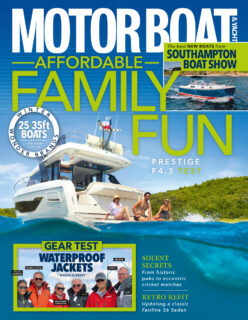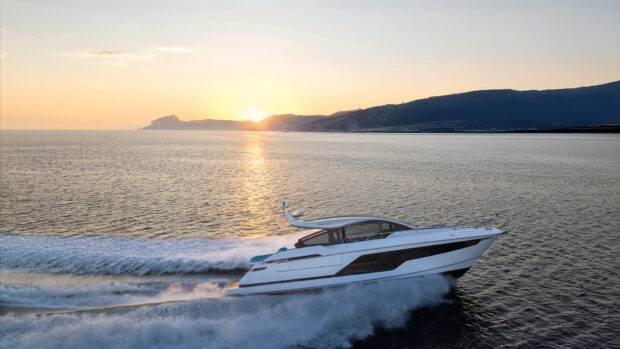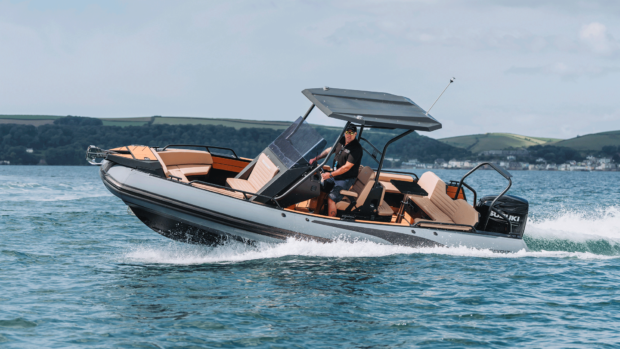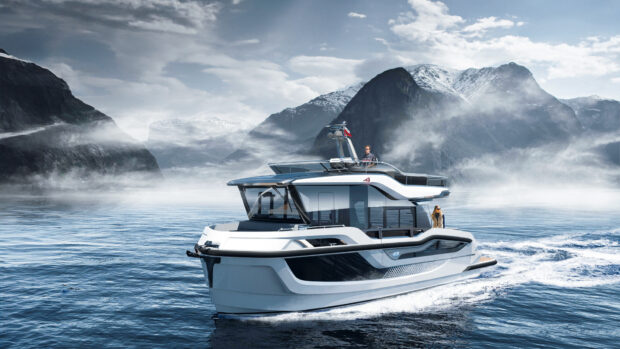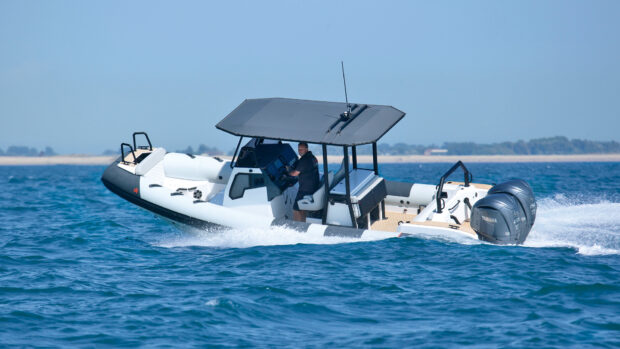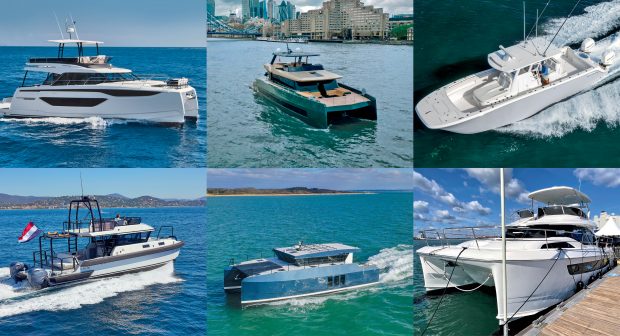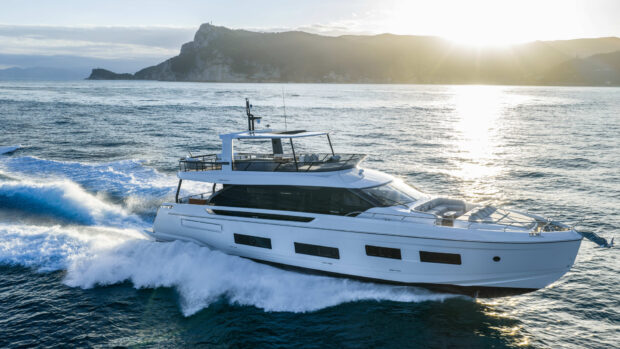Read the full dramatic story of the rescue featured in the April issue of MBY.
This is the RNLI’s full account of the extraordinary rescue featured on page 12 of the April issue of MBY. Quite long, but worth it.
At 11.35pm on Wednesday 2 November 2005, Falmouth RNLI lifeboat station was informed by Falmouth Coastguard that the MV Galina, a 32m general cargo vessel with eight people on board, had lost all power 11 miles east of Falmouth. The vessel was in danger of being driven ashore in storm force conditions. Falmouth Coastguard explained that the Coastguard Emergency Towing Vessel (ETV) Anglian Princess had been tasked to assist but her estimated time of arrival (ETA) was three hours later. The Coastguard requested the launch of Falmouth’s RNLI 17m Severn class all weather lifeboat to stand by the cargo vessel, awaiting the arrival of the ETV. A similar request was made for the launch of Fowey RNLI Trent class all weather lifeboat. The crew pagers were activated at 11.40pm.
At 11.47pm Falmouth RNLI lifeboat, launched on service. Coxswain Mark Pollard was in command and Second Coxswain Peter Wood, Mechanic David Proud, and Crewmen Tom Bird, Andrew Jenkin, David Nicoll and Carl Beardmore were on board as crew.
In the sheltered confines of Falmouth Harbour the conditions were good despite the southwesterly force 7 winds. As the lifeboat passed Zone Point on the eastern side of Carrick Roads, the wind increased but with a relatively short fetch to the east of The Lizard, the sea from the southwest was only 3-4 metres high. The weather was partly cloudy with heavy showers, visibility was good but much reduced in showers and by the wind driven spray. It was a dark night; the moon having set at 4.27pm and the next high water was due at 5.42am.
Once clear of Zone Point VHF Communication was established with the cargo vessel, but due to language difficulties, dialogue with the Latvian crew was difficult. However, a bearing on the VHF direction finding equipment (VHF DF) was noted and the course adjusted to intercept the Galina.
Despite attempts to tune the radar, there was too much sea clutter to identify the cargo vessel. Mechanic Proud therefore asked the captain to fire a flare to confirm the VHF DF bearing. The captain replied that his vessel was not carrying any flares, so he was asked if he had any other means of signalling. He said that he had a searchlight that he was asked to shine to the west in the hope the lifeboat crew would be able to see it. This was done, the beam briefly picked up and the course further adjusted towards the vessel. At just over a mile the target was distinguishable on the radar screen and Coxswain Pollard sent Tom Bird and Andrew Jenkin to the upper steering position (USP) to set up the searchlights. As soon as they were switched on and directed towards the cargo vessel the reflective strips on the safety equipment on the Galina reflected the light back strongly.
At 12.27am Falmouth lifeboat arrived on scene and the Coxswain took command from the USP. During the passage the conditions had not seemed to be too bad, as the lifeboat had been running with the sea. However, as he turned the lifeboat into the weather to allow time to assess the situation the searchlights illuminated the sea and the reality became apparent. Any lee provided by The Lizard had now been lost and the Galina was open to the full force of the gale. The wind was a steady gale force 8 but gusting up to storm force 10 from the southwest; the underlying swell height was 6-7 metres and there were wind-driven, three metre high, breaking waves. As the Coxswain and his crew looked out over the USP screen the waves were breaking at eye level. Fortunately low water had just passed and the wind over tide situation was abating.
Coxswain Pollard, recognising the Galina was not in immediate danger, decided to stand off to consider his options. He instructed Crew Member David Nicoll to continue to plot the cargo vessel on the chart and laser plotter so the rate of drift could be worked out. Then a visual inspection was carried out. The ship was in complete darkness lying beam on to the weather with her bows pointing to the northwest and rolling heavily. However, the factor that gave him most cause for concern was her construction. He could see that she had saddle tanks along most of the length of the waterline on both sides. These would have made any approach to the sides of the ship hazardous for the lifeboat, so he began to consider how he would approach the vessel should he have to take the eight crewmen off. A position and situation report was passed to Falmouth Coastguard at 12.30am.
Having conducted his reconnaissance Coxswain Pollard decided the best option for the Galina would be to await the arrival of the Anglian Princess, which would be much better able to establish and maintain a tow than the lifeboat. He therefore continued to hold station around the Galina and to plot the drift.
At 12.45am Fowey’s 14m RNLI lifeboat arrived on scene, under the command of Coxswain Keith Stuart, with six crew members on They had experienced a rough passage directly into the weather and had taken 50 minutes to cover the 10 miles but were ready to assist should they be required. At the same time Falmouth Coastguard confirmed the Anglian Princess’ ETA as 2.30am.
At 12.48am the Galina called Falmouth RNLI Lifeboat to ask if the vessel that had just arrived was the tug. They were told that the tug’s ETA remained 12.30am and that the other vessel was the Fowey lifeboat. While he was on the radio the captain was asked if his anchors were serviceable should they be needed to help slow his drift towards the shore; he confirmed that they were.
At 12.56 the two lifeboat coxswains had a discussion about the rate of drift of the Galina. They were concerned that at the present rate, approximately 1.7 knots in a north westerly direction, the cargo vessel would be within 1 mile of the shore when the Anglian Princess arrived, which would have given only about 40 minutes to secure and establish the tow. They also realised that if she drifted into the shallower water around Dodman Point the conditions would be worse and make the rescue effort even more difficult. Coxswain Stuart suggested that the Falmouth lifeboat, being the larger and more powerful boat, would be more effective at holding her off.
He contacted the captain of the Galina to inform him of his intentions and asked him to send his crew forward to prepare to receive the tow. He asked the captain to ensure that his crew were wearing lifejackets as he was concerned about them being swept overboard. He then spoke to Fowey Coxswain Stuart and told him that he was going to make two or three dry runs to get a feel for the conditions close to the cargo vessel. Coxswain Stuart said he would take up position just downwind and down sea of the Galina to act as a man overboard guard.
Coxswain Pollard briefed his crew about the practice attempts but told them that if an opportunity presented itself to get a heaving line across they should take it. He was on the USP, with Crew Members Tom Bird and Carl Beardmore manning the searchlights, keeping a lookout ahead and behind and providing observations to the Coxswain. The rest of the crew were on the aft deck. Peter Wood and David Nicoll both had heaving lines in hand with Andrew Jenkin holding the tails ready to bend the successful one on to the towrope; David Proud was ready to tend the towrope. As he waited for the crew to confirm they were ready, Coxswain Pollard noticed that the anemometer was showing a constant 45 knots with at least one gust reaching 53 knots.
At 1.09am the Galina, now 3.4 miles from Dodman Point, was still lying with her bows to the northwest. So, approaching from the southwest, Coxswain Pollard took Falmouth lifeboat across her stern, passed along her starboard side, and turned to port to come back into the weather and bring the bow of the Galina down the port side. However, as he reduced speed to try and hold position off the bow the wind caught the lifeboat’s port bow and swung her head to the west. He applied power and came away from the cargo vessel to reconsider. He decided to try a different approach and positioned the lifeboat to windward of Galina so that he could make a safe and controlled approach.
He positioned the lifeboat within about 15 metres of the Galina and, although he could have gone closer, he was worried about being swept on to Galina by the breaking seas; as it was he was using nearly 100% engine power when manoeuvring to hold her in position. Despite being relatively close, the first heaving lines failed to reach their target, instead hitting the ships side. Eventually Peter Wood managed to land a line just aft of the foc’sle at its full extent. Coxswain Pollard thought he had put the engines in neutral but the starboard was just engaged ahead and the heaving line was pulled back into the sea. He repositioned the lifeboat and prepared to try a few more attempts before resorting to a rocket line. Another three or four failed, but when David Nicoll decided to throw one vertically to see if the wind would carry it across the deck, it did and the heaving line landed securely on the Galina. Andrew Jenkin bent on the towrope and it was paid out. Throughout the manoeuvring Coxswain Pollard had not really noticed the conditions around him as he was concentrating so hard on putting the lifeboat in the right place but his crew later told him that at least two waves had broken on the front of the wheelhouse and swamped the USP. The wheelhouse had protected the crew on the aft deck.
At 1.42am the rope had been made secure on board Galina, which was now 2.5 miles from Dodman point. Coxswain Pollard then slowly applied power until the full length had been paid out and made fast on the towing post. At 1.48am he began to bring Galina head to sea. As he did so he could hear the rope creaking under the strain through the deck intercom and he realised that he would have to reduce the load if the rope was to last any time. He briefly discussed his options with Second Coxswain Wood and decided that despite the conditions, the lifeboat’s extra towrope would have to be retrieved from the port forward locker and added to the first.
Peter Wood volunteered to do this and in order to give him some protection Coxswain Pollard set a course across the sea of 140¡M. He also knew any progress made in this direction would open up St Austell Bay and give more sea room should the rope part. The second line was brought aft and shackled into the first, all way was taken off and then all the second rope was paid out. The extra weight of the rope, shackle and two thimbles in the centre of the rope helped to maintain a safe tow. Coxswain Pollard maintained a heading of 140¡M and set the power to achieve 1 knot over the ground. At 2.11am Falmouth Coastguard was informed the situation was under control with Galina being towed southeast at 1 knot, with an ETA of 2.40am for the Anglian Princess.
As soon as he was confident the situation was stable, Coxswain Pollard was relieved so that he could have a brief rest. He had been at the wheel for over 11/2 hours and giving his full concentration for over an hour while he established the tow. His foul weather gear had kept out the breaking waves but he was soaked in sweat from the effort.
At 2.27am the Anglian Princess was sighted and was called to pass a situation report and to advise her of the length of tow. At 2.39am the Anglian Princess contacted the Galina to advise her that they would be taking over the tow and that they would shortly ask for the lifeboat’s rope to be released. The Anglian Princess positioned herself to windward of the cargo vessel and illuminated the scene with her search and working lights. Coxswain Pollard described the conditions, when he saw them in the lights, as being a bubbling cauldron and Carl Beardmore commented that the waves were hissing as they went past.
At 2.43am Coxswain Pollard called for the towrope to be let go, brought the lifeboat head to sea and took all weight off. When nothing happened on board Galina he called again after three minutes and told them to cut it away if it was not possible to release it. When again there was no response, the Fowey lifeboat steamed up to the Galina to investigate and it became apparent that the crew were not even attempting to release the towline. It is not clear whether the language barrier was preventing the message getting through or whether Galina’s crew were too afraid to let go but eventually, after several radio calls from Fowey lifeboat coxswain, the tow was released at 2.56am. While waiting, Coxswain Pollard had been holding the lifeboat port bow to the weather. At least two large waves had broken on to the port side with green water at window level. Sensibly the deck crew had positioned themselves right by the wheelhouse door ready to recover the rope.
Conscious of the danger of fouling a propeller, Coxswain Pollard decided to gently make way to the sea while recovering the rope. The conditions were extremely difficult for the deck crew as the lifeboat was pitching heavily and with the weight of the rope it took 15 minutes to get the two lengths back on board.
While hove-to to disconnect the lifeboat’s towline, the cargo vessel had come round through the weather and was once again lying with her bows to the northwest. Fowey lifeboat was to the north of her acting as a man overboard guard and the Anglian Princess was positioned in preparation to pass her own tow. As she made a stern board from the southwest her crew managed to get a heaving line on to the Galina. Captain Peter Rimmer, master of the Anglian Princess, had intended to pass a wire, but, without power on the foc’sle it was too heavy and cumbersome for Galina’s crew to handle. The wire was recovered and after discussion with the Galina it was agreed that they would pass what they promised was ‘a very strong rope’. This was done and at 3.35am Captain Rimmer reported to Falmouth Coastguard that the tow was secure and they were starting passage to Falmouth.
At 3.40am Falmouth Coastguard thanked and released Fowey lifeboat that started the return passage. Falmouth lifeboat was to remain as escort. However, at 3.44am, as the weight came on the tow, the ‘very strong rope’ parted and the Anglian Princess recalled Fowey lifeboat to stand by while they prepared their own rope.
When the tow parted the Galina was 2.2 miles from Dodman point and now only 2.3 mile from Gwineas Rocks, which were now the greater hazard. The drift was taking her towards Gwineas Rocks and with the tide starting to set her to the northeast and the wind increasing, the rate was not decreasing. Falmouth Coastguard was becoming concerned about the lack of sea room and was considering the options. At 3.58am they called the Falmouth lifeboat to discuss them and asked whether the lifeboat would be able to take Galina’s crew off if the tow had not been re-established in 20 minutes. Coxswain Pollard realised whatever he tried it would be difficult as the weather had worsened further and the Galina was pitching and rolling even more heavily. The saddle tanks on the hull prevented him going alongside, the bow was too high for the crew to jump from and he didn’t want people in the water or in a life raft, as it would have been extremely difficult to recover them. He realised his only sensible option would be to heavily fender the lifeboat’s bow and make an approach to Galina’s stern. He agreed that if necessary he would attempt to evacuate the crew but also asked for a Sea King helicopter from Royal Naval Air Station Culdrose to be ready to assist.
At 4.00am the Anglian Princess was ready to make another approach; all the vessels were in the same relative positions as before. As he made his way astern Captain Rimmer noted that the anemometer was registering a wind strength of a constant 55 knots and gusting up to 60 knots – violent storm force 11. As he got close a much larger wave hit the Anglian Princess and the Galina. The aft deck of the tug was swamped and the deck crew, all large and strong men, were swept off their feet and against the side of the ship. The Galina disappeared in a wall of water and spray and Coxswain Stuart fully expected to see an empty foc’sle when the cargo vessel rolled back up again. Fortunately neither vessel lost any crew and very shortly afterwards the new tow had been passed and secured. At 4.03am the Anglian Princess reported to Falmouth Coastguard that they were all fast again.
At 4.20am Falmouth Coastguard again released Fowey lifeboat to return to station and asked Falmouth lifeboat to act as escort for the tow to Falmouth. At 4.30am the ETV and tow were fully prepared and commenced their passage.
At 4.57am the Galina reported they had managed to start their engine, and would proceed under their own power but asked that the Anglian Princess escort them; Captain Rimmer agreed. At 5.12am Falmouth Coastguard released Falmouth RNLI lifeboat and thanked them for a job well done. Despite only having nine miles to run, an ETA of 90 minutes was passed as the conditions did not allow a speed of any greater than 6 knots.
Fowey RNLI Lifeboat was on her berth, refuelled and ready for service at 5.15am, as was Falmouth RNLI lifeboat at 7.00am. The Anglian Princess escorted the Galina back to Falmouth and was eventually released at 11.04am.
In February it was announced that Coxswain Mark Pollard, 31, was to be awarded the RNLI’s Bronze Medal for fortitude, exemplary leadership and outstanding seamanship during the rescue.
Other Royal National Lifeboat Institution volunteers, Second Coxswain Peter Wood, 52, Crew Members Carl Beardmore, 45, Tom Bird, 22, Andrew Jenkin, 39, David Nicoll, 43 and full-time Mechanic David Prou,d 48, who were also on board the Falmouth RNLI lifeboat, will receive Medal Service Certificates for their crucial part in the rescue. In recognition of the valuable physical and moral support provided by Fowey RNLI lifeboat throughout the incident, a Chairman’s Framed Letter Of Thanks will be awarded to Coxswain Keith Stuart, 50.
Simon Pryce, RNLI Divisional Inspector, said: “This service was carried out on one of the wildest nights experienced along this coast for a number of years. During the crucial part of the rescue the lifeboat crews were subject to storm force 10 winds gusting to violent storm force 11.”
